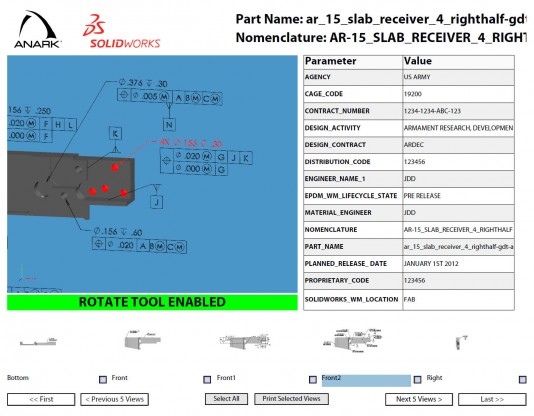The new software saves a SolidWorks model in 3D PDF together with 3D annotations, associated annotation views, and non-graphic properties.
By L. Stephen Wolfe, P.E.
For well over a decade, SolidWorks eDrawings has enabled engineers to capture 3D models and 2D drawings in a single file that can be read without a SolidWorks license. But eDrawings hasn’t caught on with large manufacturers in the aerospace and defense industries who often employ systems such as Catia, Creo (formerly Pro/Engineer), and Siemens PLM NX (formerly Unigraphics).
Many SolidWorks designers, along with users of other CAD software brands, also employ PDF files to send electronic copies of drawings to a diverse field of customers and suppliers. But until recently, sending a 3D PDF model up or down supply chains required two files: one for the 3D model and a second of a drawing showing dimensions, notes, and tolerances, and other annotations not on the model.

Several popular 3D CAD systems support ASME Standard Y14.41, which specifies how dimensions, tolerance symbols, and notes can be added directly to 3D models, thereby eliminating the need to make and manage a separate drawing file. But even though most current CAD software is capable of writing 3D PDF models, 3D annotations and related “saved views” necessary to organize them haven’t come across.
Anark’s contribution
Anark Corporation, a software company in Boulder, Colorado, has developed a SolidWorks plug-in that enables designers to save annotated 3D models as 3D PDF files. Dubbed MBEworks (for “model-based engineering”), the software saves a SolidWorks model in 3D PDF together with 3D annotations, their associated annotation views, and the non-graphic properties stored with the model.
When working with 3D PDF files, some manufacturers embed them in a 2D template that contains information that might otherwise be found in the title block of a drawing. Anark provides five ready-to-use templates with MBEworks that display this information along with check boxes that let readers choose the appropriate annotation view. The templates also display selected custom SolidWorks part properties such as the part name and number, original designer, revision number, etc. Customers can modify the templates or create new ones using Adobe Acrobat X Pro, a $799 software product that lets customers create forms and modify PDF documents.
Anark has paid close attention to details that help make 3D PDFs usable. For example, when holding the cursor over a 3D annotation, the features as well as the annotation that controls them are highlighted as they would be in SolidWorks. The 3D PDF files made with MBEworks can be viewed with the most current free version of Adobe Acrobat.
Because MBEworks uses the boundary representation form of 3D PDFs, the files can, in principle, be used by software for programming numerically controlled mills or automated inspection systems. They also can be used as an exchange medium, similar to ISO standard 10303-203 “Configuration controlled 3D design of mechanical parts and assemblies” (also called STEP).
In a demonstration at SolidWorks World, an Anark representative showed how a 3D PDF document created with Parametric Technology’s Creo Parametric software could be opened by MBEworks in SolidWorks and saved as a native SolidWorks model. All of the saved views from the Creo file came into the SolidWorks model as annotation views along with the associated annotations. (Dimension-driven design features of the Creo Parametric model are not translated because 3D PDF does not recognize such features.)

Trust but verify
Anark does its best to assure that its translation of native CAD models into 3D PDF models is accurate. It employs the native application programming interface of SolidWorks to read SolidWorks geometry and annotations and the Adobe 3D PDF Library (now owned and maintained by Tech Soft 3D) for reading and writing 3D PDF files.
With any translation process, errors may occur. Faces, edges, and continuity between faces may vary from the source to the derivative model. Curves and surfaces may be split by the translator. 3D annotations may become dissociated from the surfaces to which they were attached, and text or line work may be misplaced or dropped.
An Anark representative wrote that the company “is currently involved with other partners in a project sponsored by NIST [the US National Institute of Science and Technology] to validate the representation of this data within the 3D PDF as compared to the original native CAD source.” However, companies that plan to use MBEworks for manufacturing need to establish procedures for assuring that the quality of PDF models matches the original CAD model.
A number of third parties currently sell software that enables customers to compare source and derivative models before and after translation. The most common data-quality software looks for geometric errors (such as gaps) and deviations between the source and derivative geometry. Some of these products include CADdoctor and ASFALIS from Elysium Inc., CADIQ from ITI Transcendata, CompareWorks and Comparevidia from Capvidia, and Advance Compare from CT Coretechnologies. Software for checking that 3D annotations have translated correctly is not yet so common. CAD IQ has software for checking 3D annotations, and Elysium also has developed this capability for automobile manufacturers.
Pricing and delivery
Core MBEworks is currently undergoing beta testing. Based on the current progress of those tests, Anark expects to deliver MBEworks in April 2012. There will be two configurations: MBEworks Exchange ($4,000) exports only PDF. MBEWorks Professional ($6,950) exports additional formats including: DWG, JT, Parasolid, STEP, VRML, and Collada. Prices quoted are for single node-locked licenses. Floating licenses cost 30 percent more.
Anark also sells a stand-alone product called Anark Core Workstation that can convert PTC Creo and Siemens NX models to 3D PDFs. A version for CATIA V5 is being developed. Contact: http://www.anark.com/





